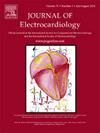儿童多系统炎症综合征的P波和QT间期离散度评价
IF 1.3
4区 医学
Q3 CARDIAC & CARDIOVASCULAR SYSTEMS
引用次数: 0
摘要
目的探讨儿童多系统炎症综合征(MIS-C)的P波、QT间期和校正QT间期离散度与临床病理的关系。方法本研究纳入60名根据美国疾病控制与预防中心诊断为misc的儿童和26名健康儿童。用12导联体表心电图测定患者的最大、最小P波持续时间和QT间期持续时间。结果miss - c患儿的p波和QT间期离散度明显大于健康儿童(p <;0.001)。此外,misc患儿治疗前P波和QT间期离散度明显大于治疗后(P <;0.001)。结论我们的研究发现,患者组P波离散度和QT离散度明显高于对照组。这与misc中出现心律失常的频率有关。我们建议患有misc的住院患者应仔细监测潜在的心律失常。本文章由计算机程序翻译,如有差异,请以英文原文为准。
Evaluation of P wave and QT interval dispersion in multisystem inflammatory syndrome in children
Purpose
To examine the associations between P wave, QT interval, and corrected QT interval dispersion and clinical pathologies in multisystem inflammatory syndrome in children (MIS-C).
Methods
This study included 60 children diagnosed with MIS-C according to the US Centers for Disease Control and Prevention criteria and 26 healthy children. Their maximum and minimum P wave durations and QT interval durations were measured by 12‑lead surface electrocardiography.
Results
P wave and QT interval dispersion were significantly greater in the children with MIS-C than in the healthy children (p < 0.001). In addition, P wave and QT interval dispersion were significantly greater before than after treatment among the children with MIS-C (p < 0.001).
Conclusions
Our study found significantly greater P wave dispersion and QT dispersion in the patient group than in the control group. This correlates with the frequency of arrhythmias seen in MIS-C. We suggest that patients hospitalized with MIS-C should be meticulously monitored for potential arrhythmias.
求助全文
通过发布文献求助,成功后即可免费获取论文全文。
去求助
来源期刊

Journal of electrocardiology
医学-心血管系统
CiteScore
2.70
自引率
7.70%
发文量
152
审稿时长
38 days
期刊介绍:
The Journal of Electrocardiology is devoted exclusively to clinical and experimental studies of the electrical activities of the heart. It seeks to contribute significantly to the accuracy of diagnosis and prognosis and the effective treatment, prevention, or delay of heart disease. Editorial contents include electrocardiography, vectorcardiography, arrhythmias, membrane action potential, cardiac pacing, monitoring defibrillation, instrumentation, drug effects, and computer applications.
 求助内容:
求助内容: 应助结果提醒方式:
应助结果提醒方式:


